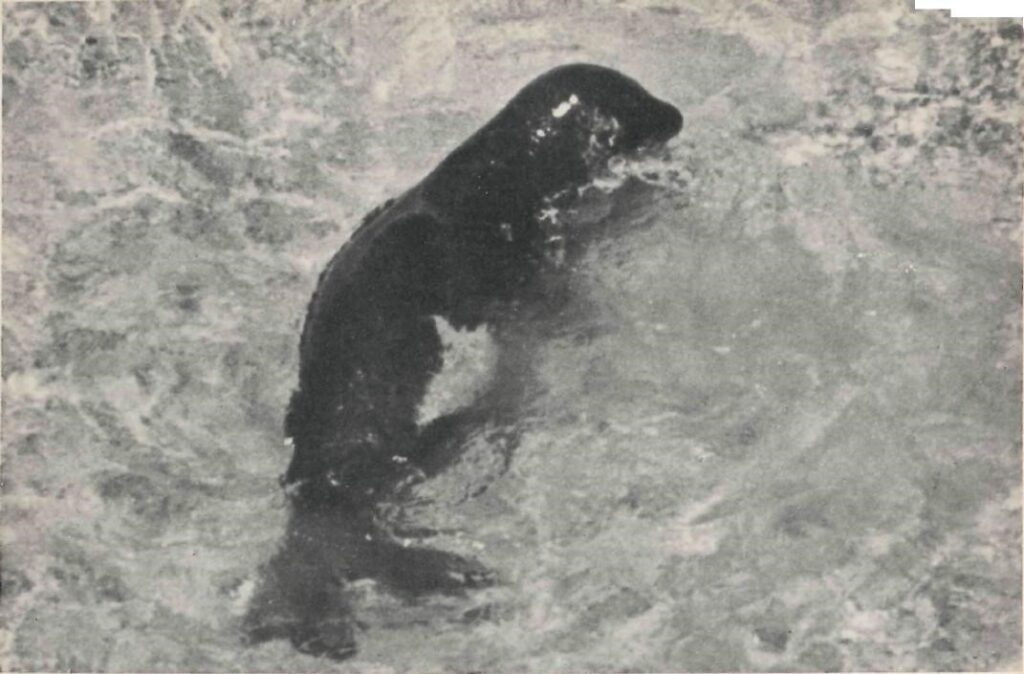Photograph by Thomas Schultze-Westrum
The Ancient Greeks exploited them commercially, mainly for their fur. When used to make boats, tents and dresses, it was said to give protection from many things, especially lightning! The right flipper of a seal when placed under the pillow was thought to cure insomnia! One of the first official coins, minted around 500 B.C., bore a picture of a seal’s head; and many places such as Phocias, the ancient district of Greece and today Phokari in the Dodecanese take their names from the Greek word for seal, foki.

Seals were once thought to be under the protection of the gods Apollo and Poseidon, because they exhibited an apparent ‘love’ of the sun and sea. For two thousand years, however, they have received protection from no one: exploited for their fur and ruthlessly destroyed by fishermen, their numbers have been reduced to a point where extinction seems a distinct possibility. Today the Mediterranean Monk Seal is one of the rarest animals in the world, the total world population estimated at about eight hundred. Scattered in small colonies throughout the Mediterranean, a large proportion of these survivors are to be found around Greece on a few of the more remote islands. Individuals, however, sometimes venture into centres of human population and occasionally become frequent visitors to busy harbours.
The next few years will probably determine whether the species survives or disappears forever from the face of the earth. Breeding is thought to occur every other year at which time a single pup is born. For successful mating and rearing of the young, the seals must find an area remote from human disturbance. They normally prefer caves on remote islands and rocks, usually choosing those with underwater entrances which up to now have been safe from fishermen. With the increase in the sport of skin diving, even these last refuges are being deserted by the seals.
The history of man’s relationship with seal populations has been very similar in many different parts of the world. From prehistoric times until the early nineteenth century, human and seal populations lived in a sort of dynamic equilibrium: men hunted the animals for their fur, oil and meat, but did not kill them in large enough numbers to decrease the population to a degree that they could not be replaced by breeding. Then, during the nineteenth century, hunting methods became more efficient and as the commercial fisheries increased, seals came into competition with man as predators of fish. Populations were decimated, almost to extinction in many cases. Finally, a modern phase ensued as people began to concern themselves with the protection of the seals: The first Grey Seals Act was passed in Britain in 1914. Since then more and more countries have followed suit and given protection to their seals. Many species thus protected have grown in number to allow for controlled exploitation, whereby a limited number of individuals may be hunted yearly. With the knowledge that we now have about the life histories and ecology of the animals, a maximum annual yield can be worked out. If no more than this number is taken yearly, the seal population will continue to be economically exploitable indefinitely.
Up until a few months ago, seals were unprotected in Greece. Fishermen have killed seals whenever they felt that they were eating too many fish or were responsible for destroying nets. A Presidential Decree recently proclaimed several deserted islets in the Western Aegean as marine reserves. The only way to ensure the survival of the seals is the creation of such sanctuaries, as remote as possible from centres of human population, where the seals can live and breed undisturbed and slowly recover their numbers.
The fate of the Mediterranean Monk Seal is a subject of much concern to conservationists throughout the world. An entire newsletter, published by the Internation Union for the Conservation of Nature, is devoted entirely to the seal — a rare distinction — and in the last year at least two European television companies have made films on the subject. Until recently, there were three species of Monk Seals in the world and the stories of the other two are a chilling illustration of the possibilities that face the Greek seals. Both these species had suffered a persecution by man similar to our seals to a point where extinction seemed almost inevitable. However the Hawaiian Monk Seal received careful protection from the U.S. Bureau of Sport Fisheries and Wildlife, and the numbers have slowly built up to the point now where they are no longer considered to be in immediate danger of extinction. The Caribbean Monk Seal was not so fortunate; protection came too late and an extensive aerial search last year failed to sight any animals at all. As the last animal was seen in 1952, it seemed very unlikely that there were any survivors and the species was officially pronounced extinct. Whether the Mediterranean Seal will follow its Caribbean relative to extinction or not is the responsibility of all the Mediterranean countries which still have small colonies. Of these, Greece probably bears the greatest responsibility as it shelters a large percentage of the total surviving world population.
Decisions taken, and enforced, during the next few years in Greece will either ensure the survival of the species — or be instrumental in bringing about its disappearance.







